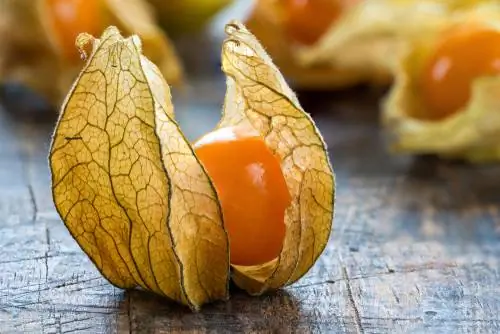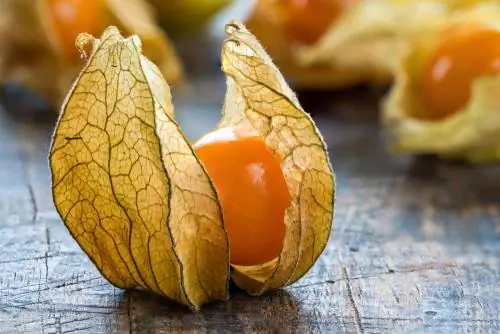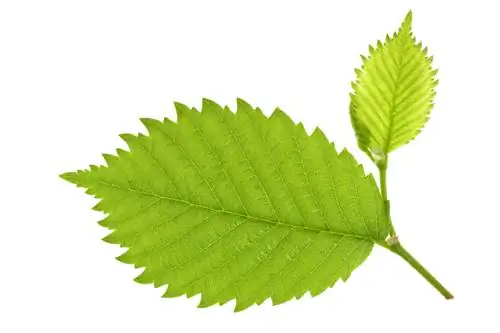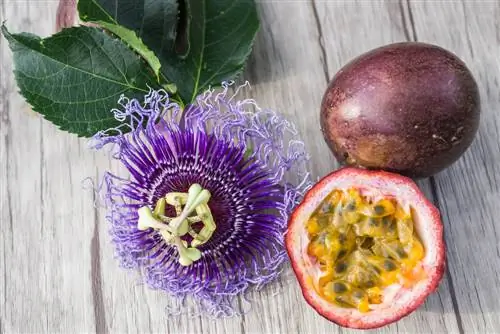- Author admin [email protected].
- Public 2023-12-16 16:46.
- Last modified 2025-01-23 11:20.
The fruit, also known as the Andean berry or Cape gooseberry, looks quite inconspicuous at first glance. The delicious, strikingly orange-colored fruit is hidden behind a rather unsightly brown shell. Once you free the berry from its prison, a big surprise awaits.

What is the Physalis fruit and what benefits does it offer?
The Physalis fruit, also known as the Andean berry or Cape gooseberry, is a sweet-tart orange berry rich in vitamin C, provitamin A, iron and phosphorus. It can be eaten raw, used in jams, liqueurs or fruit salads and offers he alth benefits.
Physalis is a hit in terms of taste and he alth
The first surprise is of a culinary nature, because the small fruit tastes very aromatic, sweet and sour. The firm flesh is very juicy and cracks easily when you bite into it. But not only is the cherry-sized fruit great for snacking on, it is also extremely he althy. The Andean berry contains a lot of provitamin A as well as iron and phosphorus. In addition, 100 grams of the delicious fruit cover our daily requirement for vitamin C. Enjoying this small, exotic cherry is worth it in several ways.
Nutritional values of Physalis
And this is what 100 grams of the small fruit from South America contains:
- very low in calories with an average of 80 kcal
- approx. two grams of protein
- about 12 grams of carbohydrates
- and about one gram of fiber
Preparation of the fruit
Since the berry is surrounded by a paper-like shell and is attached to it quite tightly, preparing it for consumption or further processing takes a little work. First of all, remove the shell: To do this, bend the sepals downwards, grasp the fruit with two fingers and finally twist them out with light pressure. Don't be surprised if the physalis feels a little sticky: this is by no means any pesticide residue, but normal. If you want, you can rinse the berries under running water and then continue using them.
Storage of Physalis
If you have Physalis bushes on your balcony or in your garden, you will probably harvest more berries than you can eat. In this case, you can rest assured because thanks to the natural protective coating, ripe, freshly harvested Physalis can be stored for a few weeks. However, the prerequisite is that they are cooled to a maximum of 10 to 12 °C. On the other hand, if you buy Physalis, then remove the plastic film. Otherwise the fruits will quickly start to mold.
This is how the physalis is prepared
Physalis can be eaten raw, frozen or dried. The fruits also taste good as jam, liqueur or in a colorful fruit salad.
Physalis jam
For an exotic physalis jam you need the following ingredients:
- 500 grams of ripe physalis
- a mango
- two kiwis
- Juice from a lemon
- a vanilla pod / a bag of vanilla sugar
- 500 grams of preserving sugar (2:1)
Prepare the physalis as described and quarter the fruits. The other fruit is also peeled and cut as small as possible. Halve the vanilla pod and scrape out the pulp. Now put all the ingredients together with the preserving sugar in a pot and puree them. Now place the pot on the stove and let the mixture boil. Remove any foam with a ladle. The jam needs to simmer for about five minutes. As soon as it starts to gel (do a gelling test!), you can pour it into small glasses. Bon appetit!
Tip
For a fruity Physalis liqueur, let 500 grams of Physalis, 250 grams of brown sugar, the contents of a sachet of vanilla sugar together with the contents of a bottle of vodka steep in a well-sealed container for at least six weeks. Shake the container daily so that the sugar dissolves. The liqueur also tastes great with a mango-physalis mixture.






